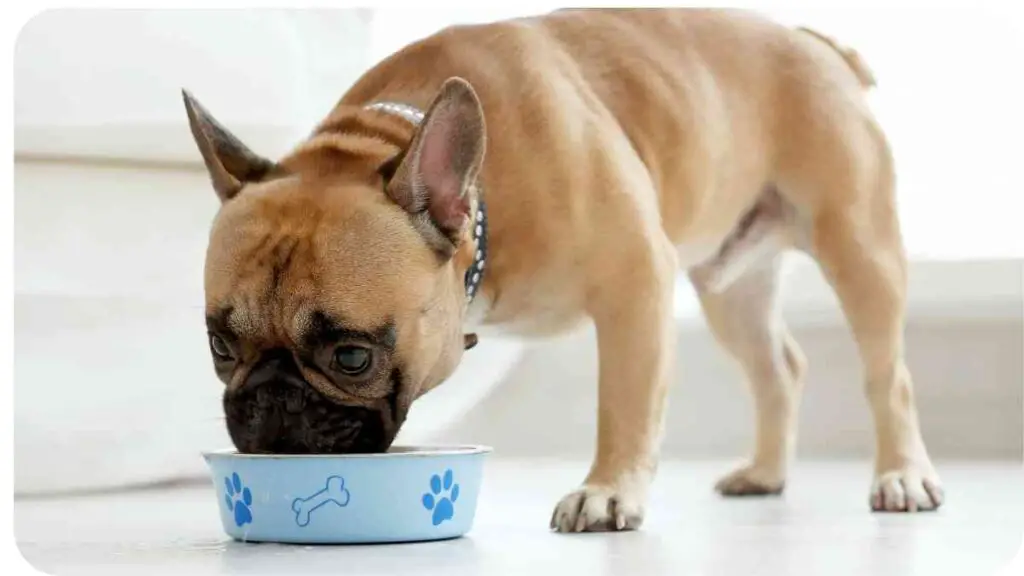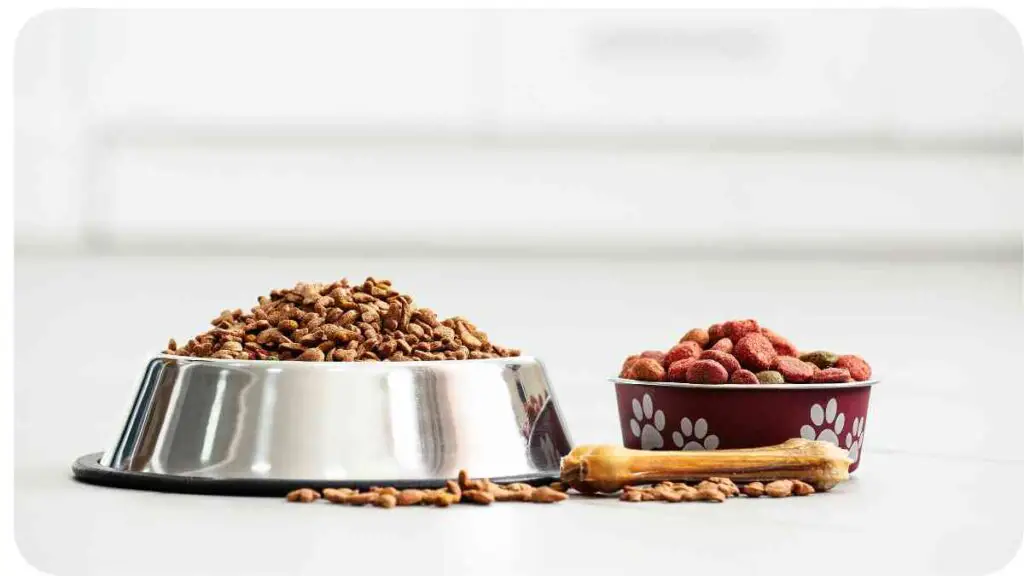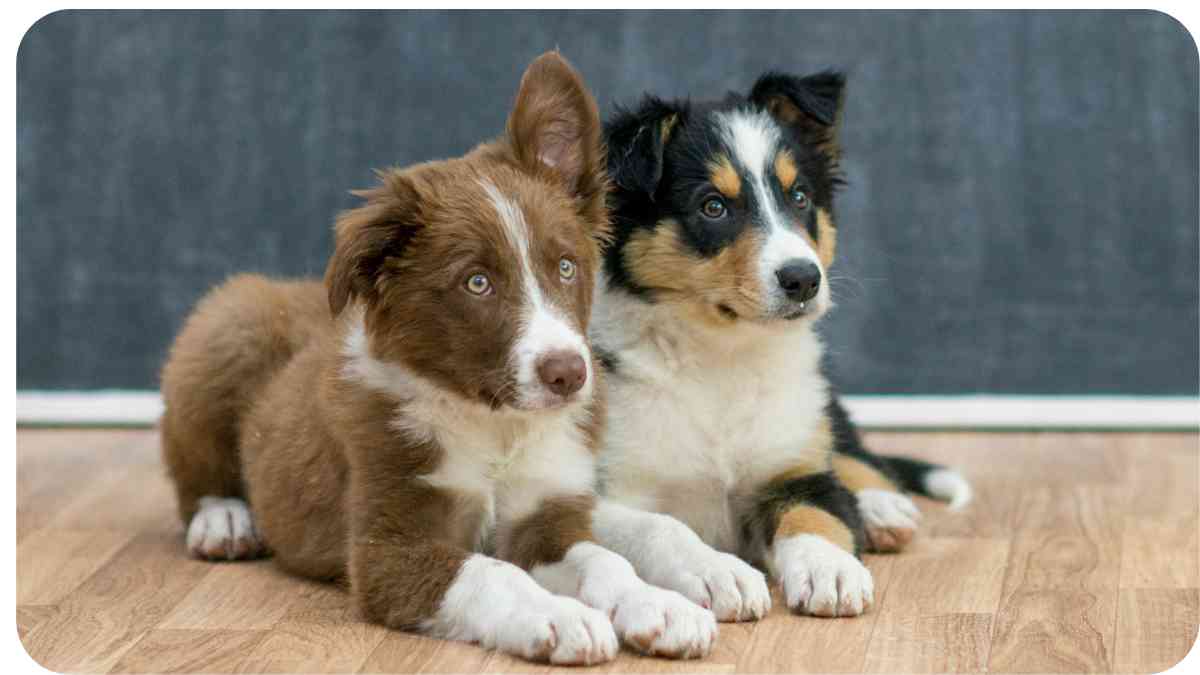Calories are units of energy that our bodies (and our pets’ bodies) use to function. In dog food, calories provide the energy your pet needs for daily activities, growth, and overall health.
Just like us, dogs burn calories through physical activity and basic bodily functions. If they consume more calories than they burn, they might gain weight; if they consume fewer, they might lose weight. It’s all about balance.
| Key Points |
|---|
| Understanding the caloric content of your dog’s food helps ensure they are fed the right amount of energy. |
| Dry dog food generally has more calories per cup than wet food, so portion sizes may differ. |
| Caloric needs vary based on your dog’s size, breed, activity level, and age. |
| Use the Resting Energy Requirement (RER) formula to calculate your dog’s daily caloric needs. |
| Automated feeders can aid in portion control, but consider their suitability for your dog’s needs. |
| Regularly monitor your dog’s weight and adjust food portions as necessary to maintain a healthy weight. |
| Treats should be included in the total daily caloric intake to prevent overfeeding. |
| Consult with your vet for personalized advice on your dog’s diet and caloric needs. |
Why Caloric Content Varies in Dog Foods

Not all dog foods are created equal when it comes to calories. The caloric content of dog food can vary based on several factors:
- Ingredients: High-protein or high-fat ingredients often mean more calories.
- Formulation: Dry kibble usually has more calories per cup compared to wet food.
- Brand: Different brands use varying ingredient blends, affecting calorie content.
When managing your dog’s diet, it’s crucial to know how much food they need. For guidance on portion sizes, check out How Much Food Should a 15-Pound Dog Have a Day?. This resource provides essential feeding guidelines for your pet.
Table: Common Ingredients in Dog Food and Their Caloric Content
| Ingredient | Calories per Cup |
|---|---|
| Chicken | 335 |
| Beef | 400 |
| Lamb | 350 |
| Sweet Potato | 200 |
| Rice | 215 |
| Peas | 120 |
How to Measure Calories in Dog Food
Reading the Nutrition Label
One of the simplest ways to determine how many calories are in your dog’s food is to check the nutrition label. The label should provide the number of calories per cup or per serving. This is usually expressed as kcal (kilocalories) which is the standard measurement for food energy.
Understanding Caloric Density
Caloric density refers to how many calories are packed into a specific amount of food. High-calorie foods have more energy per cup compared to lower-calorie foods. This is important because it helps in controlling portion sizes and ensuring your dog is getting the right amount of energy.
The Average Caloric Content of 1/2 Cup of Dog Food
Dry vs. Wet Food: Caloric Differences
Dry food (kibble) is generally more calorie-dense than wet food. This means that 1/2 cup of dry food often has more calories than 1/2 cup of wet food. The reason is that dry food has less moisture content compared to wet food.
Understanding your dog’s hydration needs is important for their overall health. To learn more about water content in dogs, visit How Much of a Dog’s Body Weight is Water?. This article offers insights into maintaining proper hydration for your pet.
Factors Influencing Caloric Needs
Your Dog’s Size and Breed
Larger breeds generally need more calories compared to smaller breeds. For example, a Great Dane will have different caloric needs compared to a Chihuahua. It’s essential to consider the size and breed when determining how much food to offer.
Activity Level and Metabolism
Active dogs, such as working dogs or those that get a lot of exercise, may require more calories compared to a less active dog. Likewise, a dog’s metabolism can impact how efficiently they use the calories they consume.
Age and Health Considerations
Puppies and pregnant or lactating females usually require more calories for growth and development. Conversely, senior dogs often need fewer calories as their metabolism slows down.
Table: Daily Caloric Needs by Weight and Activity Level
| Weight (lbs) | Sedentary (kcal/day) | Active (kcal/day) |
|---|---|---|
| 10 | 200 | 300 |
| 20 | 350 | 500 |
| 50 | 700 | 900 |
| 70 | 900 | 1200 |
Calculating Your Dog’s Daily Caloric Needs

Using the Resting Energy Requirement (RER) Formula
The RER formula helps calculate the basic caloric needs of your dog. The formula is:
RER=70×(body weight in kg)0.75\text{RER} = 70 \times (\text{body weight in kg})^{0.75}RER=70×(body weight in kg)0.75
Once you have the RER, you can adjust for activity level by multiplying by a factor ranging from 1.2 (for a sedentary dog) to 2.0 (for a very active dog).
Choosing the right food is vital for your Alsatian’s health. Discover the best options by referring to Best Food for Alsatian Dogs: Top Choices. This guide will help you select the most suitable diet for your Alsatian dog.
Adjusting for Activity Level
Multiply the RER by the activity factor to get the total daily caloric needs. For example, if your dog’s RER is 500 kcal and they are moderately active, you would calculate:
Total Daily Calories=RER×1.5=500×1.5=750 kcal/day\text{Total Daily Calories} = \text{RER} \times 1.5 = 500 \times 1.5 = 750 \text{ kcal/day}Total Daily Calories=RER×1.5=500×1.5=750 kcal/day
Table: Daily Caloric Needs by Weight and Activity Level
| Weight (lbs) | Sedentary (kcal/day) | Moderately Active (kcal/day) | Very Active (kcal/day) |
|---|---|---|---|
| 10 | 200 | 250 | 300 |
| 20 | 350 | 450 | 550 |
| 50 | 700 | 900 | 1100 |
| 70 | 900 | 1150 | 1400 |
How Much Should You Feed Your Dog?
Matching Caloric Intake with Caloric Needs
To ensure your dog maintains a healthy weight, you need to match their caloric intake with their daily needs. This means adjusting portion sizes and choosing the right type of food to meet their energy requirements.
Portion Control Tips
Use a measuring cup or kitchen scale to accurately measure your dog’s food. This helps avoid overfeeding or underfeeding. Remember, consistency is key, and feeding your dog at regular times each day helps manage their weight effectively.
Common Mistakes in Feeding Dogs
Overfeeding vs. Underfeeding
Overfeeding can lead to obesity, while underfeeding can cause malnutrition. Both can have serious health implications for your dog. Make sure to follow the feeding guidelines on the dog food label and adjust based on your dog’s weight and activity level.
If your dog is suffering from a yeast infection, effective treatment is crucial. For practical advice on managing this condition, see How to Treat a Yeast Infection on Your Dog’s Paw. This article provides useful tips for treatment and care.
Misinterpreting the Feeding Guidelines
Feeding guidelines are general recommendations. They might not always suit your individual dog’s needs. Always consider factors like age, breed, and activity level when determining the right amount of food.
Adjusting Caloric Intake for Weight Management
Strategies for Weight Loss
If your dog needs to lose weight, you can reduce their caloric intake and increase their activity level. Consult with your vet to create a balanced weight loss plan.
Strategies for Weight Gain
For underweight dogs, increase their caloric intake with nutrient-dense foods and treats. Ensure you’re providing a balanced diet that includes proteins, fats, and carbohydrates.
Table: Caloric Adjustments for Weight Management
| Goal | Adjustment Strategy |
|---|---|
| Weight Loss | Reduce daily calories by 10-20% |
| Weight Gain | Increase daily calories by 10-20% |
The Role of Treats in Daily Caloric Intake
Counting Treats in the Total Caloric Intake
Treats can contribute a significant amount of extra calories. Make sure to account for them in your dog’s daily caloric intake to prevent overfeeding.
Healthy Low-Calorie Treat Options
Opt for treats that are low in calories but high in nutrients. Some great options include baby carrots, apple slices (without seeds), and small pieces of cooked chicken.
Special Considerations for Puppies and Senior Dogs

Caloric Needs for Growing Puppies
Puppies need more calories to support their rapid growth. Look for puppy-formulated foods that provide the necessary nutrients and energy.
Adjusting Caloric Intake for Senior Dogs
Senior dogs may require fewer calories due to decreased activity levels. Additionally, choose foods that support joint health and overall well-being.
Glucosamine is often used to support joint health in pets. To understand the appropriate dosage for your cat, check How Much Glucosamine Can I Give My Cat?. This guide offers detailed information on glucosamine supplementation for your feline friend.
Health Risks of Incorrect Caloric Intake
Obesity and Related Health Problems
Obesity can lead to serious health issues like diabetes, heart disease, and joint problems. It’s essential to monitor your dog’s weight and adjust their diet accordingly.
Risks of Underfeeding
Underfeeding can result in malnutrition, which can affect your dog’s coat, energy levels, and overall health. Ensure your dog is getting a balanced diet with adequate calories.
Tips for Transitioning Dog Foods
How to Switch Dog Foods Without Upsetting Their Stomach
Gradually mix the new food with the old food over a week to prevent digestive issues. This helps your dog’s stomach adjust to the new diet.
Using Technology to Track Your Dog’s Caloric Intake
Calorie Tracking Apps for Pets
Several apps can help you track your dog’s caloric intake and monitor their weight. These apps offer features like feeding reminders and weight tracking.
Pros and Cons of Automated Feeders
Automated feeders can help with portion control and consistent feeding times. However, they might not be ideal for all pets
Pros and Cons of Automated Feeders
Automated feeders offer convenience, especially if you have a busy schedule. They can help ensure your dog receives the right portion of food at the right times. However, they might not suit all pets. Some dogs might be anxious or hesitant around automated feeders, and they might not be suitable for dogs with special dietary needs. Here’s a quick look at the advantages and disadvantages:
Table: Pros and Cons of Automated Feeders
| Pros | Cons |
|---|---|
| Consistent Portions | Initial Cost |
| Convenient for Busy Owners | Not Ideal for All Pets |
| Scheduled Feeding Times | Requires Maintenance |
| Can Reduce Overfeeding | Limited Customization |
Conclusion
Understanding the caloric content of your dog’s food is crucial for maintaining their health and well-being. By knowing how many calories are in 1/2 cup of dog food and considering factors like your dog’s size, activity level, and age, you can make informed decisions about their diet.
Monitoring their weight, adjusting their food portions, and being aware of the calories in treats can help prevent issues like obesity and malnutrition.
Remember, each dog is unique, and what works for one might not work for another. Always consult with your vet to tailor your dog’s diet to their specific needs.
Final Thoughts on Feeding Your Dog Correctly
Feeding your dog correctly isn’t just about the quantity of food it’s about providing a balanced diet that meets their nutritional needs. With the right knowledge and tools, you can ensure your furry friend stays healthy, energetic, and happy. Whether you’re using automated feeders, tracking calories with apps, or simply measuring their food, the goal is to create a feeding routine that works best for both you and your pet.
Further Reading
- How Many Calories Should Your Dog or Cat Eat Daily? – Dunloggin Veterinary Hospital
This article provides a comprehensive guide on determining the daily caloric needs for dogs and cats, offering practical tips for pet owners to ensure their pets are fed appropriately. - Dog Dry Foods Caloric Content – Franklin Animal Clinic
A detailed PDF document listing the caloric content of various dry dog foods, helping you compare different brands and make informed decisions about your dog’s diet. - How Many Calories Are in Dog Food? – A Pup Above
This blog post breaks down the caloric content of dog food, explaining how to interpret nutritional labels and make the best food choices for your dog.
FAQs
How do I calculate my dog’s daily caloric needs?
To calculate your dog’s daily caloric needs, start by determining their Resting Energy Requirement (RER) using the formula 70×(body weight in kg)0.7570 \times (\text{body weight in kg})^{0.75}70×(body weight in kg)0.75. Then, multiply the RER by a factor based on their activity level (e.g., 1.2 for sedentary dogs, 1.5 for moderately active dogs, and 2.0 for very active dogs).
What factors influence the calorie content of dog food?
The calorie content of dog food is influenced by the ingredients used, the food’s formulation (dry vs. wet), and the brand. Ingredients high in protein and fat typically have more calories, and dry foods are generally more calorie-dense compared to wet foods.
How can I adjust my dog’s diet for weight management?
To adjust your dog’s diet for weight management, reduce their caloric intake or increase their activity level. For weight loss, cut back on daily calories by 10-20% and ensure the food is nutritionally balanced. For weight gain, increase caloric intake by 10-20% with high-quality, nutrient-dense foods.
Can I use automated feeders to manage my dog’s caloric intake?
Yes, automated feeders can help manage your dog’s caloric intake by providing consistent portions and scheduled feeding times. However, ensure the feeder is suitable for your dog and their specific dietary needs, and monitor their weight regularly to make any necessary adjustments.
What should I do if my dog is overweight or underweight?
If your dog is overweight, consult with your vet to develop a weight loss plan that includes a controlled diet and increased exercise. For underweight dogs, increase their caloric intake with high-nutrient foods and consult your vet to rule out any underlying health issues.

I am Dr Hellen James a veterinarian, pet lover, and writer. I have many years of experience caring for pets, including dogs, cats, birds, and fish (and even axolotls!). I love spending time with the animals in my life, especially when they are sick or need love.

